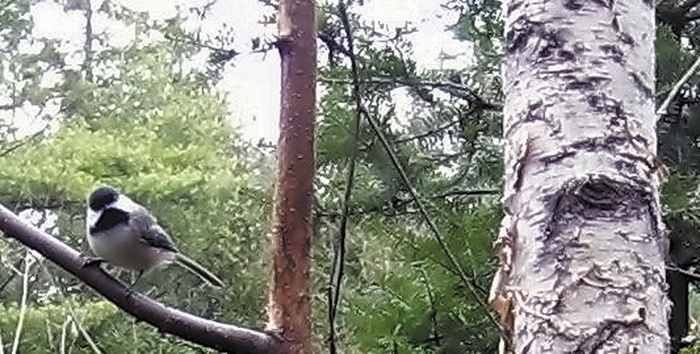In our woods, the easiest birds to identify that aren’t crows or blue jays are the chickadees.
Black-capped chickadees, they are, though more north of here you can sometimes spot the boreal chickadees, who have a brown cap on their heads instead of black.
Their songs differ, too, or so I read, since I believe I’ve never heard the boreal chickadee sing. They named themselves: “Chickadee-dee-dee,” they shout from deep in our oaks, birches, maples, firs and pines. They repeat several other phrases, including, sort of, “seet” and “day-day-day,” and a two-note tune which, with my guitar tuned by electronic device to A-440, I’ve measured as descending exactly a half-tone. I’ve heard A to A-flat, A-flat to G, and E to E-flat. You might transcribe the first note as a dotted quarter note, and every so often the second note breaks into a third.
Starting in about April and into summer, this “fee-bee” phrase gets sung a lot. According to the researchers, only males who are at some distance from the rest of the flock and from their own nests sing it. It appears to be a territorial marker, as they’re sociable but feisty little birds who live together in groups of about six to 12. It could also (imagining outward from what I’ve seen and heard in my own woods and books) be a communication with the mate. “Where are you?”
I can’t say for sure, though. I can tell you that one June afternoon a chickadee was repeating the two-note tune nonstop for about half an hour. Imagining he was lonely, I whistled back. There was a long pause after my first whistle. Probably it sounded so goofy to the chickadee that he wondered if somebody was hurt. But then he tried again. I answered, and this time he called right back. Or so I interpreted it, and I think I was right because our whistles went back and forth as if we were conversing.
“What’s he saying?” I said to my wife, Bonnie, who was digging around in plant pots on the deck.
“He either thinks you’re his girlfriend or he’s trying to get you to fill the feeder,” she said.
“I doubt if it’s the feeder,” I said, because chickadees eat mainly caterpillars, bugs and spiders, and they hit the feeder mostly in winter when the bug store is depleted. They actually store up bugs by cramming them into the cracks of trees and coming back for them later.
We whistled back and forth for 10 or 15 minutes. Eventually I thought of other things to do and wandered into the house.
In a little while Bonnie said from the deck, “I think you broke its heart.”
“What do you mean?”
“After you went inside,” she said, “it kept trying to get your attention. It got almost frantic, and then gave up.”
Now, this could have a lot of possible meanings, because chickadee females have a tendency to, well, stray off with males they like better. I might have sounded to the chickadee cuckold like a wife who was asking to come home again. Or like another female looking for a fling.
This could all be hopeless musico-anthropomorphizing. But maybe not.
A study of their calls some years ago concluded that chickadees talk to each other about danger. The “seet” call indicates to the rest of the flock that some rapidly moving predator, such as a hawk, is in the neighborhood, and to watch out.
“Chick-a-dee-dee” is known to the ornithologists as a mobbing call, because it means “flock together, everybody” to harass and drive off an intruder, or at least make it harder to single out anyone in the flock. Subtle variations on chick-a-dee-dee indicate there’s a stationary danger nearby, and even its size and threat level, such as that of a cat or a perched owl. Other variations convey information about food and the caller’s identity.
Who the little fellow I was talking to thought I might be, I of course have no idea. But interspecies communication is not unheard of. Researchers have also found that nuthatches, who also forage in our woods, appear to speak some chickadee and understand some of the warning calls much better than I understood the two-note tune.
There is more in the chick-a-dee-dee-dees than is dreamt of in our philosophy, apparently.
Dana Wilde lives in Troy. His writings on Maine’s natural world are collected in “The Other End of the Driveway,” available from Booklocker.com. Backyard Naturalist appears the second and fourth Thursdays of the month. You can contact him at naturalist@dwildepress.net.
Send questions/comments to the editors.



